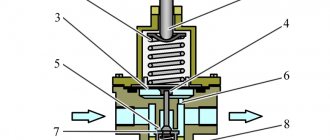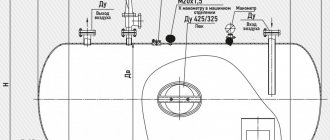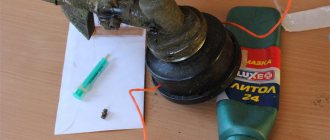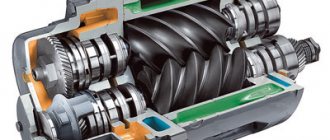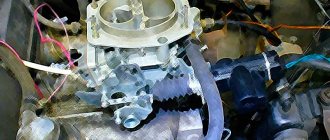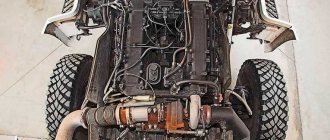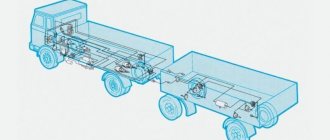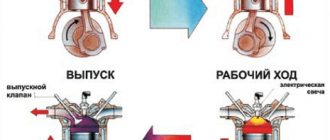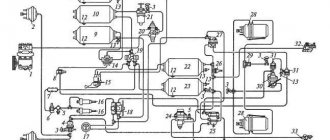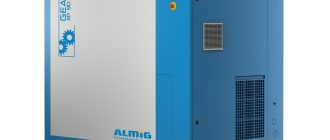Compressor dryer
The first and very important step when working with pneumatic equipment is the preparation of compressed air. It is known that the air produced by the compressor has a relative humidity of 30 to 90 percent. The entry of such an amount of moisture into pneumatic tools and other equipment can lead to corrosion of individual parts of the installation and breakdown of the operating system as a whole. Therefore, drying compressed air is a necessary measure when supplying it to equipment.
Types
According to the principle of operation, compressed air dryers are divided into two main types: refrigeration and adsorption
Refrigerated
The most famous and affordable is the refrigerated compressed air dryer. The principle of its operation is to cool the air and remove excess moisture in the form of droplets, which accumulate in condensate drains and are removed from the system. Cooling occurs using equipment similar to a regular refrigerator or air conditioner, which is why they are also called refrigeration dehumidifiers. In this way, you can reduce air humidity to a dew point of at least +3°C.
Despite their apparent simplicity, refrigerated compressor dryers are complex high-tech equipment. All processes in modern models occur automatically. In large installations, and when high control accuracy is required, microprocessor controllers are used for control.
The operating process of the compressor dryer is simple:
- In a heat exchanger, the heat brought by the compressed air is absorbed by the already cooled air moving in the opposite direction. No additional energy is required for this. At this stage, about 60% of the moisture contained in the compressed air condenses.
- The compressed air passes through a refrigerated heat exchanger and is cooled to reach its dew point. The refrigerant is circulated by a compressor. The remaining moisture in the compressed air is cooled to reach the condensation pressure and is automatically removed.
The main disadvantage of this type of compressed air drying is the limited ability to reduce the dew point temperature.
Adsorption
Adsorption dryers for compressors are filled with a special substance that absorbs moisture from the air passing through it. This principle of drying compressed air makes it possible to guarantee a lower dew point (up to -70 degrees), which allows the use of pneumatic equipment at low ambient temperatures, as well as in the pharmaceutical, electronic and food industries.
Adsorption type compressed air dryers consist of two columns through which air passes. One is in drying mode, while the other is purged in regeneration mode, using part of the compressed air for this.
Manufacturers
One of the leaders in the production of compressed air dryers is the Italian company FRIULAIR. Its products are distinguished by high quality, ease of use and reliability. At the same time, the price of an air dryer for compressors remains at an affordable level.
Refrigerated compressed air dryers from this manufacturer have a capacity from 350 to 150,000 l/min, which are characterized by a low pressure drop (0.01 bar) and a constant dew point (+3 degrees) under all operating conditions. The use of installations from this manufacturer can significantly reduce the consumption of electricity, and their components do not have a harmful effect on the environment.
FRIULAIR adsorption models allow you to obtain a compressed air dew point of -20, -40 and -70 degrees. A molecular sieve is used as an adsorbent, which is replaced after 3-5 years. This product includes a fine filter and a dust filter. Both filters are conveniently located and do not take up much space. The noise absorbers are easily removed and can be replaced if necessary. These models do not require high maintenance costs, are quite compact and durable. They are equipped with an electronic controller that monitors the operation of the installation and displays all data on the monitor. Using it, you can control energy savings, select the dew point and the method of operation of the device.
By purchasing an appropriate filter and compressed air dryer, you not only increase their service life, but also make the entire pneumatic system more efficient and optimal. Therefore, this equipment must be taken very seriously.
Negative factors of the presence of moisture in the pneumatic system.
- water condensate, mixing with oil, creates an emulsion, clogging the cavities of pneumatic systems, causing breakdowns;
- condensation causes corrosion of air supply lines, oxide debris and dust contaminate pneumatic devices and lead to their breakdown;
- at subzero temperatures, condensate can freeze in pipelines and cause ruptures or significantly reduce permeability;
- when painting, drops of liquid lead to inhomogeneity of the paint layer;
- during pneumatic transportation of powdered materials (including in sandblasting units), excess moisture causes sticking and blocking of the transported product;
- most often condensate is unacceptable in the pharmaceutical, food and electronics industries;
When planning a dehumidification system for your production, you can use the following standards: International standard DIN ISO 8573-1 : establishes 6 classes of air purity and the maximum permissible content of various types of impurities, including moisture content, corresponding to each class.
| Cleaning class | Maximum residual oil content, mg/m3 | Maximum residual solids content | Maximum residual moisture content | ||
| particle size, microns | number of particles, mg/m3 | g/m3 | compressed air dew point, °C | ||
| 1 | 0,01 | 0,1 | 0,1 | 0,003 | -70 |
| 2 | 0,1 | 1 | 1 | 0,117 | -40 |
| 3 | 1 | 5 | 5 | 0,88 | -20 |
| 4 | 5 | 15 | 8 | 5,953 | +3 |
| 5 | 25 | 40 | 10 | 7,732 | +7 |
| 6 | — | — | — | 9,356 | +10 |
There is a similar Russian GOST 17433-80 . When choosing the necessary equipment, you should be guided by the maximum permissible values of impurity content and humidity specified for the equipment.
| Pollution class | Solid particle size, microns, | Content of foreign impurities, mg/m GOST 17433-80 (ST SEV 1704-79) Industrial purity. Compressed air. Pollution classes (with Change No. 1), no more | ||
| no more | Particulate matter | Water (liquid) | Oils (liquid) | |
| 0 | 0,5 | 0,001 | Not allowed | |
| 1 | 5 | 1 | ||
| 2 | 500 | Not allowed | ||
| 3 | 10 | 2 | Not allowed | |
| 4 | 800 | 16 | ||
| 5 | 25 | 2 | Not allowed | |
| 6 | 800 | 16 | ||
| 7 | 40 | 4 | Not allowed | |
| 8 | 800 | 16 | ||
| 9 | 80 | 4 | Not allowed | |
| 10 | 800 | 16 | ||
| 11 | Not allowed | |||
| 12 | 12,5 | 3200 | 25 | |
| 13 | Not regulated | 25 | Not allowed | |
| 14 | 10000 | 100 | ||
Notes:
1. The content of foreign impurities is indicated for air reduced to the following conditions: temperature 293.15 K (20 ° C) and pressure 1013.25 hPa (760 mm Hg).
2. The solid particle size is taken as the largest measured value.
Advantages and disadvantages of adsorption dryers
The main advantages of adsorption devices are their low energy consumption, the ability to operate effectively at fairly low temperatures, without the danger of moisture freezing in the device. In addition, this device is capable of drying air without heating it.
The disadvantage of devices of this type can be considered the need to periodically replace the adsorbent material, due to a decrease in its efficiency and contamination. Disadvantages also include the rather high cost of the devices and the considerable costs of their maintenance. If you do not have the opportunity to purchase this device, you can always make a desiccant dehumidifier with your own hands.
How to dry compressed air?
To produce compressed air, the air flow enters a compressor where it is compressed. But any air contains moisture in one concentration or another. After being compressed by the compressor, it enters the piping system for further distribution. It is in the pipes that moisture condensation occurs. If the air system is not equipped with a desiccant, then during a work shift, at an air humidity of 75% and a temperature of 20C⁰, moisture condensation occurs, about 160 liters. Condensation leads to tragic consequences: corrosion and premature failure of lines and equipment.
Compressed air is used for many manufacturing processes. One of them is the painting of products, for which the presence of condensate in the pipeline is simply unacceptable and leads to defective products.
To remove moisture from the air duct system, highly efficient adsorption compressed air dryers are used, which come in several types:
- Dryers without heat
- Heated air drying devices
- Installations with external air heating and forced ventilation
There are desiccants that use the heat of compressed air. This type of dryer uses heat from the compressor as a heating element, which must be removed.
But just like household dehumidifiers, each type of compressed air dryer has its own advantages and disadvantages. For your reference, we will provide brief information on each type of such equipment.
- Equipment that does not use heating has the advantages of achieving an extremely low “dew point”, explosion and fire safety. Disadvantages: high cost and quite expensive maintenance, including periodic replacement of the absorbent substance. The use of such units increases the cost of produced compressed air by a quarter.
- Heating, compressed air devices have the following advantages: reduced losses during adsorbent regeneration, high efficiency of moisture absorption. Disadvantages of the equipment: additional energy consumption for the heating element.
- Installations with external heating and forced ventilation have advantages: no losses during dehumidification, achieving low “dew point” values. Disadvantages of the devices: installation requires a fairly large area, as well as the high initial cost of the equipment.
- Installations that use the heat of compressed air also have a lot of advantages and disadvantages. The advantages of the devices can be considered: low energy costs and the minimum required area for equipment installation. Disadvantages: Desiccants can only be used with oil-free compressors, as well as with air compression devices that produce constant high temperatures.
The use of adsorption dehumidifiers for domestic and industrial needs makes it possible to effectively remove moisture from the air flow under any temperature conditions.
Purpose and principle of operation
Excess moisture in pipes, in vapor and liquid aggregate states, can lead to serious problems, including stopping production. The most likely consequences of the presence of moisture in the pneumatic network include:
- Freezing of open sections of air ducts.
- Corrosion of air lines.
- Breakdown of pneumatic tools, valves and other shut-off valves, etc.
To remove water vapor, special devices called compressed air dryers are used. These devices effectively remove water vapor from the air, preventing moisture from entering various technical processes. The operating principle of a dehumidifier depends on its type.
Principle of operation
The operating principle of a condensation-based dehumidifier is based on the physical process of condensation, when moisture turns into a liquid state due to the contact of air with a cool surface. A condensation dryer works as follows:
- Using a fan, air is forced into the device body.
- In the housing, the air passes through two series and connected heat exchangers.
- When passing through the first heat exchanger with a low surface temperature, moisture condenses from the air. It collects on the surface of the heat exchanger and flows into the condensate collection tank.
- When filling the container, excess is removed from the device using a drainage tube.
- Condensation occurs due to the transfer of temperature from air to freon, the refrigerant actively evaporates.
- The evaporated freon from the first heat exchanger enters the compressor.
- From the compressor, freon is supplied to the condenser (second heat exchanger).
- Cooled air, when passing through the second heat exchanger, condenses freon. The air receives heat and heats up.
Operating principle of a condensation dehumidifier using the example of the “DH TIM 20 E1B” model
The main disadvantage of a condensing device is the increase in outlet temperature. The temperature change can be about 5 degrees. If for objects with a large area such heating is not critical, then for small rooms it can create serious inconveniences.
An adsorption dryer carries out the process of removing moisture due to the physical process of adsorption, that is, the concentration of dissolved moisture and its absorption by the adsorbent. In a device operating on this drying principle, the following processes occur:
- The fan draws air into the device through a special lattice opening.
- Humid air passes through the rotor blades, which are filled with silica gel. The adsorbent absorbs moisture from the air.
- The dried air passes further and is removed from the device. After passing through the rotor, part of the air is discharged through a special channel back to the rotor. It passes through the heater and returns to the rotor blades. Passing through a rotating element with moistened silica gel, the air provokes the desorption process (the process of reverse removal of moisture from the adsorbent). The released moisture in a liquid state enters the heat exchanger and is discharged into a condensate container.
Such dehumidifiers require serious maintenance on an ongoing basis. In addition, they are quite expensive.
Principle of operation
The operating features of the installation are as follows. The compressed air enters one of the columns, which contains an adsorption dryer, and the adsorbent (it fills the tower) absorbs all excess moisture. The dried air travels further along pneumatic lines to the consumer.
Often such a device operates on a timer, and after a certain period (on average 4 hours), the tower through which the compressed air penetrated switches to the function of removing moisture from the adsorbent. When the first column begins regeneration, the second one closes and begins to pass air through itself. Then the cycle repeats.
Recommendations for operation and maintenance of the air dryer
The dehumidifier does not require special maintenance during the entire operating time, however, the desiccant cartridge must be replaced at least once a year. Over time, the adsorbent loses its properties and the dehumidifier begins to work less efficiently. It is difficult to track the deterioration of the dryer, so you should simply change the cartridge once a year or even more often (depending on operating conditions).
Replacing the cartridge is simple: you need to unscrew the cartridge (hand effort is enough) and remove the old gasket, wipe the place where it is installed, install a new gasket (it is advisable to lubricate it with a small amount of oil) and screw on the new cartridge. In this case, work should be carried out with the air supply to the dryer turned off (you can wait until the receivers are completely filled and the compressor is turned off, or simply disconnect the line on the compressor side).
If the dryer valves or integrated pressure regulator fail, the entire unit is replaced as an assembly. However, it is possible to replace the muffler separately, which quite often fails.
With regular replacement of the cartridge and timely repairs, the dryer will reliably protect the pneumatic system of the car from water and the negative consequences caused by it.
Application area
Such devices are used in almost all technological processes where an air mixture with no or minimal moisture content is required. Most often these devices are used:
- In the chemical, pharmaceutical, oil refining industries.
- In the production of telecommunication cable products.
- For driving pneumatic tools.
- In air control systems.
- In paint booths.
- In the braking system of heavy vehicles and trains.
Due to the high cost of dryers, many managers of small enterprises refuse to use such equipment, thereby increasing the risk of failure of the entire pneumatic system. In small-scale production, to power pneumatic tools, instead of a full-fledged dryer, you can use moisture separators (cyclones) installed in front of each consumer.
Condensation
Calorex monobloc dehumidifier for small pools
The operating principle is based on the condensation of water vapor contained in the air on the surfaces of the evaporator at a low temperature. In essence, an air dehumidifier (hereinafter referred to as an air conditioner) is an air conditioner that does not have the function of removing heat from the room.
Water vapor condenses on the surface of the evaporator and is removed. Any condensing-type heating agent works with overheating of the air in the room, since the pumped air successively passes through the evaporator and condenser. At the same time, latent and sensible heat is removed from the air (that is, the air is cooled and dried accordingly), then the air is overheated just by that same latent heat. The heat generated by the compressor and fans also contributes to air heating, as a result of which it is possible to increase the air temperature at the supply from the dehumidifier by 4-6°C, which, in turn, is not critical for rooms with a large volume, but can be significant for small ones premises.
Calorex Delta duct dehumidifier for large swimming pools
The most common applications of condensing dehumidifiers are:
- during construction or finishing work (small mobile OV for faster drying of walls, while achieving good savings due to reduced downtime);
- for warehouses (including pharmaceuticals), archives, museums, libraries, galleries, laundries (where conditions regarding air humidity are strict);
- bathrooms, swimming pools, saunas (where there is significant moisture evaporation from the water surfaces, where increased humidity creates ideal conditions for the formation of fungus);
- basements, attics (where low temperatures and excess humidity create ideal conditions for fungus);
- pools for raising fish (just as for ordinary pools, there is significant moisture evaporation from the pool water surface, it is also necessary to maintain humidity at 55-65%, otherwise damage to the building structures will be caused and fungus will form);
- power plants and pumping stations (moisture removal due to moisture evaporation);
- ceramic, textile, agricultural and wood processing industries (for drying products).
Why high air humidity is bad
Along with temperature, air humidity is one of the most significant factors affecting human well-being.
Unfortunately, in our country it is somehow not customary to think about this, although in other countries much attention is paid to regulating the content of water vapor in the air. First, let’s determine what level of air humidity is considered optimal.
According to research, a person feels most comfortable in the humidity range between 40% and 60%. It is when air humidity is between 40-60% that our body most effectively fights airborne infections, such as the flu. In this range, the protective properties of the human respiratory system are activated, mental activity improves, the heart works with minimal overload, etc.
But not only our body suffers from a lack or excess of air humidity, too much water vapor also negatively affects the environment in the house - the cladding and even the building structures themselves can become unusable if they are not designed for such conditions.
And if we are talking about production or warehouse premises, then increased moisture content is even more dangerous, so in some enterprises it is absolutely impossible to do without reducing air humidity.
Operating principle of a condensing type air dryer
Here are just some of the problems that can arise in waterlogged areas:
- the appearance and spread of mold and other fungal organisms;
- swelling and deterioration of wooden structures, such as floors;
- corrosion of metal structures;
- penetration of moisture into computer equipment, other devices and mechanisms, risk of short circuit;
- the risk of injury due to the formation of drips and puddles on the floor covering;
- reduction in the thermal insulation properties of building and finishing materials;
- the emergence of a risk of defects in technological processes in production;
- freezing of open sections of air ducts;
- deterioration of consumer qualities and damage to goods in waterlogged warehouses.
This list goes on and on.
Relative humidity.
The ratio of actual air humidity to the maximum possible humidity of compressed air at a given temperature can be described as “relative humidity” (DIN ISO 7183).
Calculation example:
Ambient air temperature: 20°C
Max. steam transfer capability at 20°C: 17.31 g/m3
Weighted relative humidity (using hydrometer): 60%
Actual amount of water vapor = (17.31*60%) / 100% = 10.38 g/m3
The practical meaning of the above calculations: This degree of humidity (atmospheric) air will have the following results: when the temperature drops to +12°C, the vapors do not condense because Max. the possibility of water vapor transfer is slightly higher than the calculated value of 10.38 g/m3 - therefore, in this case the dew point is around 12°C.
Where are dehumidifiers used?
There are quite a few places where you can find dehumidifiers. Household dehumidifiers are often purchased by those who live in humid climates with frequent precipitation, as well as those who are forced to live in semi-basements or, conversely, under the roof itself.
Most often, dehumidifiers are installed in private homes, but it must be emphasized that recently there has been an increased demand for dehumidifiers for apartments. Apparently this is due to the appearance on the market of less expensive and more economical and easy-to-use models. The existing model range makes it possible for people with almost any income level to buy a dehumidifier.
| Other TopClimat.ru publications on the topic |
| What is a dehumidifier |
| How to choose a dehumidifier |
However, household dehumidifiers are not yet available in all homes. But industrial air dehumidifiers are practically irreplaceable:
- in industrial premises where air humidity is critical;
- in warehouses, granaries, archives;
- in museums, galleries, exhibition halls, libraries;
- in hospitals and clinics;
- in swimming pools and baths, in gyms and water parks;
- in basement and semi-basement work areas;
- at construction sites - to ensure the quality of finishing and other construction work.
There are also special compressed air dryers. As you know, compressed air is widely used in various technological processes. For example, the doors of public transport are opened using a pneumatic drive. But the air that enters the compressor always contains a significant amount of water vapor.
During the compression of the air mixture, this vapor becomes concentrated, which leads to its condensation in the pipes of the pneumatic network. With all the ensuing unpleasant consequences. Therefore, before supplying air to the compressor, it must be removed from excess moisture, and compressed air dryers or air dryers for compressors are responsible for this. Most often, a refrigerated air dryer is used to dry compressed air.
Separately, it is necessary to say about the dehumidifier for the pool. This type of equipment is indispensable in any room where there is an open water surface and where air humidity must be carefully controlled in order to achieve optimal comfort.
The purpose of compressed air drying is to:
- eliminate the formation of condensation in air transportation systems and especially in equipment components;
- minimize the appearance of corrosion;
- minimize the effects of aggressive water-oil emulsion;
- prevent the growth of microorganisms (food and pharmaceutical industries);
- compliance of the compressed air produced with the purity class specified by the technological process (GOST 17433-80, ISO 8573-1).
General structure and operating principle of the air dryer
Structurally, the dehumidifier consists of two blocks:
- Cast valve body and pressure regulator;
- Air dryer cartridge.
The body contains all the main components of the dryer, ensuring its operation and control of the pneumatic system: pressure regulator, group of valves (return, safety and others), body heater, etc. There are also air channels in the housing, and all the necessary pipes and fittings are located on its surface. At the bottom of the body there is a muffler (“mushroom”).
A desiccant cartridge is attached to the top of the body by means of a thread - it plays a key role in removing moisture from the air. The cartridge contains a cylindrical air-permeable container with granular adsorbent, which is supported in the lower part by air filters (usually made of fibrous materials), and pressed at the top by a spring. At the bottom of the cartridge there is one central threaded hole (for installation on the housing) and a number of smaller peripheral holes - in general, the design of the drying cartridge is very similar to the design of an oil filter.
The dehumidifier works as follows. Compressed air from the compressor enters the dryer body and is directed through the channel into the cartridge (to a number of peripheral holes). Here the air passes through the adsorbent, on which the bulk of the moisture contained in it is deposited. At the same time, the filters retain mechanical impurities. After drying, the air exits through the central opening of the cartridge, is directed through the dryer channels to the pressure regulator and safety valves, and then enters the system through several lines (usually to two autonomous circuits and to a regeneration receiver).
Over time, the concentration of liquid in the adsorbent increases, and it loses its ability to absorb new moisture. Therefore, the dehumidifier is periodically regenerated - this operation consists of backflushing the dehumidifier with air from the regeneration receiver. The air passing through the adsorber dries it and, together with moisture, leaves the dryer through a special valve. Since the release of air is accompanied by intense noise, a muffler is installed on the dehumidifier.
In the cold season, at temperatures below +5...+7°C, the heating element in the dehumidifier automatically turns on. This is necessary to maintain a positive temperature of the adsorbent regardless of the ambient temperature. At sub-zero temperatures, the water in the desiccant may freeze, which not only reduces the effectiveness of the desiccant, but can also lead to its deformation and rupture.
There is a special connector on the dryer body to connect and control the heater and valves. 24 V dryers are installed on KAMAZ, MAZ vehicles and PAZ and LiAZ buses.
The dryer is mounted on the right side member of the frame, and some of the receivers are located here. The dryer is connected to the compressor and receivers through metal and rubber tubes.
